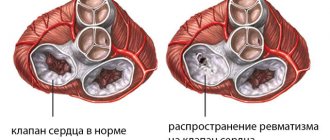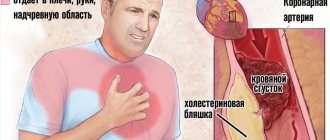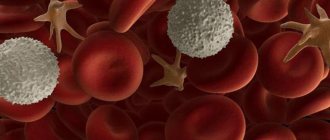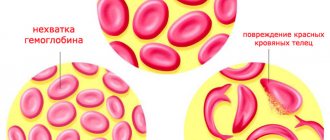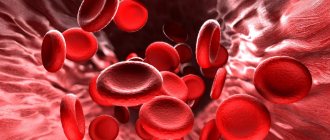general description
Leukemia (leukemia, blood cancer, leukemia) is a tumor disease of the hematopoietic system (hemoblastosis), associated with the replacement of healthy specialized cells of the leukocyte series with abnormally changed leukemic cells.
Leukemia is characterized by rapid expansion and systemic damage to the body - the hematopoietic and circulatory systems, lymph nodes and lymphoid formations, spleen, liver, central nervous system, etc. Leukemia affects both adults and children, and is the most common childhood cancer. Males get sick 1.5 times more often than women. Leukemia cells are not capable of full differentiation and performing their functions, but at the same time they have a longer life expectancy and a high division potential. Leukemia is accompanied by a gradual displacement of populations of normal leukocytes (granulocytes, monocytes, lymphocytes) and their precursors, as well as a deficiency of platelets and red blood cells. This is facilitated by the active self-reproduction of leukemia cells, their higher sensitivity to growth factors, the release of a tumor cell growth stimulator and factors that inhibit normal hematopoiesis.
Leukemia
In a normal state, cells in the body are subject to division, maturation, performance of functions and death in accordance with the program that is embedded in them. After the death of cells, their destruction occurs, after which new, young cells appear in their place.
As for cancer, it implies a violation in the program of cells regarding their division, life and functions, as a result of which their growth and reproduction occur beyond any control. Leukemia is essentially a cancer that affects bone marrow cells - cells that in a healthy person are the beginning of blood cells (leukocytes and red blood cells (white and red blood cells), platelets (blood platelets).
- Leukocytes (aka white blood cells, white blood cells). The main function is to provide protection for the body from the effects of foreign agents, as well as direct participation in the fight against processes associated with infectious diseases.
- Erythrocytes (aka red blood cells, red blood cells). In this case, the main function is to ensure the transfer of oxygen and other types of substances to the tissues of the body.
- Platelets (aka blood platelets). Their main function is to participate in the process that ensures blood clotting. It should be noted the importance of this function for the blood as it is considered in the form of a protective reaction necessary for the body in case of significant blood loss accompanying vascular damage.
People who have developed blood cancer are faced with disruptions in the processes occurring in the bone marrow, due to which the blood is saturated with a significant number of white blood cells, that is, leukocytes, deprived of the ability to perform their inherent functions. Cancer cells, unlike healthy cells, do not die in due time - their activity is focused on circulation through the blood, which makes them a serious obstacle to healthy cells, whose work, accordingly, becomes more complicated.
Leukemia and leukemia are synonyms for each other, indicating, in fact, blood cancer. Both of these definitions act as the correct name for the disease relevant to their processes. As for blood cancer, this definition is not correct in terms of considering it from a medical point of view, although it is this term that has become most widespread in use.
A more correct name for blood cancer is hemoblastosis, which means a group of tumor formations formed on the basis of hematopoietic cells. A tumor formation (the tumor itself) is an actively growing tissue that is little subject to control by the body; in addition, this formation is not the result of the accumulation of unmetabolized cells in it or the result of inflammation.
Hemoblastoses, the tumor cells of which damage the bone marrow, are defined as leukemias or lymphomas. Leukemias differ from lymphomas in that, firstly, some of them have systemic damage (leukemia), while others do not have it (lymphomas). The terminal (final) stage of lymphoma is accompanied by metastasis (which also affects the bone marrow).
To summarize the general description of the disease, let us highlight its features. Thus, blood cancer refers to a tumor that develops on the basis of a single cell directly related to the bone marrow. This implies an uncontrolled and constant division of it, occurring within a certain time interval, which can range from several weeks to several months.
In this case, as already noted, a concomitant process is the displacement and suppression of other blood cells, that is, normal cells (suppression determines the effect on their growth and development). Symptoms of blood cancer, taking into account these features of the impact, will be closely related to the lack of one or another type of normal and functioning cells in the body.
Essence of the disease
Leukemia causes changes in the white cells (leukocytes) contained in the blood, both in a quantitative aspect (their number grows very rapidly) and in a qualitative aspect (they stop performing their functions). In a healthy person, platelets, leukocytes and red blood cells are formed in the bone marrow. In a patient with leukemia, the number of blasts in the blood - immature pathologically altered cells that interfere with the growth of healthy cells - increases significantly.
Human blood consists of plasma and formed elements. White cells in the blood are called leukocytes and their main role in the human body is protection. White blood cells are formed in the bone marrow, mature and are released into the circulatory system (like platelets and red blood cells). With leukemia, the bone marrow forms a very large number of white bodies, which do not have time to mature and, accordingly, perform their main functions.
TV show on this topic
Cancer cells multiply rapidly, and this leads to the fact that there is no food or space left for healthy cells.
Leukemia therapy
A patient with this disease is completely isolated, and his room is constantly (at regular intervals) treated with bactericidal ultraviolet lamps to destroy harmful microbes.
Treatment of leukemia is aimed at suppressing the development of blasts and destroying those immature cells that have managed to get into the blood. The production of immature leukocytes is stopped with the help of cytostatics; they can be destroyed using radiation therapy.
But such therapy is often dangerous for the human body. Because in addition to the fact that it destroys pathogenic microbes. In addition to everything, it also destroys healthy ones. As a result, the patient feels sick and vomits, and feels general weakness after therapy. And also his hair begins to fall out, which leads to baldness.
To restore immune processes in the body, doctors prescribe glucocorticoid medications.
This is where we will finish our story about leukemia, what kind of disease it is and how to treat it. Take care of yourself and your health!
Leukemia (leukemia): types, signs, prognosis, treatment, causes
The causes of leukemia and the factors that provoke it may be the following:
- Exposure to ionizing radiation. The increase in risk does not depend on the dose of radiation received, and the chance of getting leukemia occurs even with minor radiation exposure;
- Taking certain medications, including those often used in chemotherapy. The most dangerous are antibiotics from the penicillin family, chloramphenicol, butadione. A leukemic effect is possible for benzene and some pesticides;
- A viral infection, it can provoke a mutation, and under certain circumstances the cells can degenerate into malignant ones. The highest incidence of leukemia is observed during HIV infection;
- Hereditary disease. Although the mechanism of inheritance has not been fully studied, heredity is a common cause of leukemia in children;
- Genetic pathologies and smoking.
Leukemia is a serious blood disease that is classified as neoplastic (malignant). In medicine, it has two more names - leukemia or leukemia. This disease knows no age restrictions. It affects children of all ages, including infants. It can occur in youth, middle age, and old age.
What exactly causes the mutation of blood cells is currently not fully understood. But it has been proven that one of the factors causing leukemia is radiation exposure. The risk of disease appears even with small doses of radiation. In addition, there are other causes of leukemia:
- In particular, leukemia can be caused by leukemic drugs and some chemicals used in everyday life, for example, benzene, pesticides, etc. Leukemia drugs include antibiotics of the penicillin group, cytostatics, butadione, chloramphenicol, as well as drugs used in chemotherapy.
- Most infectious viral diseases are accompanied by the invasion of viruses into the body at the cellular level. They cause mutational degeneration of healthy cells into pathological ones. Under certain factors, these mutant cells can transform into malignant ones, leading to leukemia. The largest number of leukemia diseases is observed among HIV-infected people.
- One of the causes of chronic leukemia is a hereditary factor that can manifest itself even after several generations. This is the most common cause of leukemia in children.
Blood cancer, or leukemia, spreads quite quickly throughout the body, so it needs to be diagnosed in time to avoid irreparable consequences.
It all starts with a mutation in a bone marrow cell, which immediately turns a white blood cell into an infected cell. Unfortunately, today the exact reasons for this process are not yet known. The new cancer cell divides very quickly, resulting in many cells that weaken healthy white blood cells. The disease “leukemia” can lead to irreversible consequences if the necessary measures are not taken in a timely manner.
About the reasons
The causes of leukemia have not yet been fully studied by medicine. But there are circumstances that lead to the development of blood leukemia in adults and children. What causes leukemia?
The causes of leukemia are:
- Exposure to radiation. If the body is once exposed to a large radiation dose, including during radiation therapy.
- Long contact with benzenes. This happens at chemical industrial facilities, during smoking, and constant gasoline intoxication.
- Exposure to certain chemotherapy drugs.
- Pathological processes affecting chromosomes (the syndrome described by Klinefelter, Down's disease).
- Long-term immunodeficiency.
- Blood pathologies (inherited underdevelopment of bone marrow structures, aplastic anemia).
In leukemia, hereditary causes are very rare. These are the causes of leukemia.
Leukemia and pregnancy
Close attention should be paid to the presence of leukemia in pregnant women, although such a combination is very rare. It is very difficult for those with leukemia to become pregnant. Pregnancy with chronic leukemia (leukoblastoma) has a more favorable prognosis for the mother than with its acute course. But even with acute and chronic leukemia, pregnancy will be accompanied by anemia, which can be normochromic and hyperchromic.
There are several forms of anemia in which pregnancy is contraindicated and is terminated:
- Chronic iron deficiency anemia grade 3 and 4;
- Hemolytic anemia;
- Bone marrow hypo- and aplasia;
- Acute leukemia.
Treatment of leukemia in other ways
If a person is diagnosed with leukemia, treatment of the disease may include the following basic methods.
Chemotherapy
The appropriate type of medications are used, which can destroy cancer cells.
Radiation therapy or radiotherapy
The use of a certain radiation allows not only to destroy cancer cells, but also to shrink lymph nodes, spleen or liver, the enlargement of which occurred due to the processes of the disease in question.
Stem cell transplantation
This procedure allows you to restore the production of healthy cells and at the same time improve the functioning of the body's immune system. The transplantation can be preceded by radiotherapy or chemotherapy, which can sometimes easily destroy a certain number of bone marrow cells, weaken the effect of the immune system and make room for stem cells.
It is worth noting that weakening the immune system is of great importance, since otherwise the cells transplanted into the patient may begin to be rejected. White blood is a deadly disease, the treatment of which must be taken as seriously as possible. If appropriate measures are taken in a timely manner, complete recovery can be achieved.
For many years now, cancer has been the most terrible disease for doctors and patients. They are difficult to treat, especially in the later stages of development. One of the types of oncology is blood cancer. This disease is characterized by the formation of a tumor from one type of cell that begins to multiply uncontrollably in the blood. As a result, healthy blood cells are replaced by pathological ones. How to defeat cancer, and what symptoms this disease has.
Chemotherapy is not the only way to cure leukemia. In cases where there is suspicion that cancer cells may affect the spinal cord or brain, X-ray therapy (radiation) is prescribed.
In addition, treatment is often carried out with medication. There are drugs (for example, cytostatics) whose action is aimed at suppressing cancer cells. Glucocorticoid hormones help strengthen the body's immune system.
Children are helped to fight the disease with bone marrow transplantation. The essence of the procedure is that bone marrow is transplanted from a donor to a sick child. Cells that have just taken root in a new environment contribute to the active activity of the bone marrow, which has a positive effect on the patient’s well-being.
Forecast
What a terrible disease leukemia is known, perhaps, all over the world. The prognosis of such a pathology depends only on the treatment performed. It is possible for about 60% of people to achieve remission. After a bone marrow transplant, young people can live for about 8 years without developing the disease. For childhood leukemia, the prognosis is more favorable. As many as 95% of children will achieve remission; the disease can recede for 5 years without showing any symptoms. If the disease returns again, then achieving remission is also possible, and the child should receive a bone marrow transplant, which is taken from a donor.
Nutrition for leukemia
Since during the treatment of leukemia the patient loses a lot of energy, various side effects from radiation appear, and it is necessary to eat well, diversify the food with vitamins. It is recommended to avoid eating fried, smoked foods, alcohol, and consume a minimum of salt. It is also advisable not to consume caffeine, tea, or Coca-Cola, as these drinks interfere with the absorption of iron, which is so lacking in leukemia. Your diet should definitely include foods that are rich in antioxidants: apples, carrots, garlic, berries.
Why does the disease develop?
Many patients are interested in the question of where blood cancer comes from. This is not surprising, because each of us wants to protect ourselves from this disease. Today, doctors already know the mechanism of development of blood cancer. Leukemia is a cancer of the blood. The disease can occur at any time in a completely healthy person, but there are a number of factors that can influence the development of the disease.
Our body is a single life support system. Blood plays a vital role in this system. It nourishes all organs and tissues with oxygen and essential valuable substances. Blood is made up of several types of cells that are produced in the bone marrow. Today doctors distinguish three main types of blood cells:
- Leukocytes are cells of the immune system.
- Platelets are cells responsible for tissue integrity.
- Red blood cells are cells responsible for feeding the entire body.
At some point, under the influence of certain factors, one of the cells may cease to be part of a harmonious system. She begins to multiply at tremendous speed. As a result, these extra cells crowd out healthy ones, and the body begins to suffer. Uncontrolled cells simply take food away from normal molecules, preventing them from multiplying and performing their functions. Blood cancer causes:
- Radiation.
- Chemical poisoning.
- Genetic predisposition.
You can get cancer in hazardous industries or when cleaning up the consequences of accidents at nuclear power plants. However, there are cases when pathology begins to develop for no apparent reason. Doctors do not know the complete list of factors that cause cancer. The appearance of abnormalities in a blood test is a signal for additional examinations.
3.Leukemia symptoms
Leukemia symptoms depend largely on what type of leukemia a person develops, but common leukemia symptoms include:
- Increased temperature and increased sweating at night;
- Headache;
- Tendency to bruising and bleeding;
- Bone pain or joint pain;
- Swelling or pain in the abdomen due to an enlarged spleen;
- Enlarged lymph nodes in the armpits, neck, or groin;
- Frequent infections and illnesses;
- Feeling very weak and tired;
- Weight loss.
About our clinic Chistye Prudy metro station Medintercom page!
Forms of pathology
The course of leukemia can occur in two forms - chronic and acute. It is worth noting that the transition from one form to another is impossible. In the chronic form, the disease progresses extremely slowly and has no symptoms. This form of leukemia is determined by a blood test even before the patient begins to feel any symptoms and signs of the disease. The acute form is the opposite, the disease develops quickly and is accompanied by characteristic symptoms.
Leukemia can be classified according to several other characteristics, namely:
- The rate of progression of the disease;
- Type of infected leukocytes.
Affected cells, in turn, can also be divided into several types:
- Lymphocytic leukemia is a cancer in which lymphocytes are quickly affected and grow;
- Myeloid leukemia is a cancer that affects only granular leukocytes.
Cancer is the general name for the malignant proliferation of one of the blood cells. This is how patients began to call it, doctors use other definitions. Cancer in the blood cannot be seen or removed by surgery. This is a special form of cancer, which has several types. This disease is classified according to the type of mutating cells. Today doctors distinguish the following types of blood oncology:
- (myeloid leukemia, lymphocytic leukemia, monocytic leukemia, Megakaryocytic leukemia).
- (, monoblastic, megakaryoblastic, erythromyeloblastic).
- Paraproteinemic hemoblastoses (myeloma, heavy chain disorders, macroglobulinemia).
- Hematosarcoma (lymphloid, immunoblastic, histiocytic)
- Lymphoma (Hodgkin, B-cell, Non-Hodgkin).
- Angioma.
- Myeloma.
- Lymphosarcoma.
Each of these diseases is called differently and has its own characteristic features of course and development. However, early diagnosis is of great importance for the treatment of each of them.
Doctors’ further prognoses depend on what type of cancer is detected in the patient. Cancer in the blood how long do they live? Doctors answer this question that patients with the chronic form have more favorable prognoses. According to statistics, cancer is detected in the blood more often in women than in men. The risk group includes elderly patients who may develop myeloma. Myeloma is dangerous because of its multiple tumor foci.
Incomplete remission - the disease has positive dynamics as a result of the therapy performed.
Relapse: If two tests taken 2 weeks apart reveal more than 5% blast cells in the red bone marrow, a relapse is confirmed. However, the blood test may be normal.
Terminal stage - there is increasing thrombocytopenia, anemia, granulocytopenia, lack of results from cytostatic treatment and an increase in cancer growth.
The question of where leukemia comes from and what can influence the activation of its development interests many. There is no person who would not want to know who is at risk for developing this terrible disease in order to protect themselves from the occurrence of a pathological condition in the hematopoietic organs. But, unfortunately, today no scientist can accurately name the reasons for the onset of leukocyte mutation. Although several risk factors have been identified that contribute to the occurrence of an oncological process in the bone marrow and accelerate its progression.
These include:
- Some diseases are infectious or viral. The invasion of the structure of the hematopoietic cell by certain viruses, influenza, herpes, HIV, provokes the occurrence of an irreversible mutation in it with subsequent malignancy.
- Exposure to radiation. Increased background radiation contributes to the appearance of disturbances in the chromosomal composition of blood cells, as a result of which their malignant degeneration can begin. • Long-term influence on the body of carcinogenic substances, toxins and some drugs from a number of cytostatics or antibiotics. Their influence disrupts the DNA of the cell, which provokes its malignancy.
- Genetic predisposition. Scientists have established with certainty that leukemia can make itself felt even after several generations. If it is known that one of a person’s ancestors died of blood cancer, he is at risk for developing this disease and should be more attentive to his health.
Therapeutic measures to help cope with the disease
Treatment of leukemia can only be carried out in cancer centers with special equipment. All attempts of a person who finds out that he has leukemia to cure the disease using folk methods will end in failure.
Therapy for malignant lesions of hematopoietic tissues that have led to mutation of leukocytes consists of the following therapeutic measures:
- Chemotherapy courses. Antitumor drug treatment is the main method to stop the development of leukemia. Chemotherapy for this disease is carried out for a long time, because its goal is not only to achieve remission, but also to prevent relapses.
- Biological therapy. Patients diagnosed with leukemia are required to be prescribed courses of treatment with immunomodulatory drugs, since these drugs help stimulate the immune system and activate a person’s own defenses to fight blood cancer.
- Transplantation of bone marrow tissue consisting of stem cells. The question of the possibility of transplantation, the most effective method of treating leukemia, is decided in each clinical case individually, based on the results obtained during diagnosis.
Leukemia in an advanced stage (after the enlargement of the liver and spleen has occurred) is very difficult to treat. In this case, the main treatment method becomes palliative therapy, which makes it possible to stop the painful manifestations of the oncological process and alleviate the person’s condition.
Prevention
Prevention of the disease consists in consuming a sufficient amount of zinc (it is involved in the process of hematopoiesis), it is worth including seafood in the diet, as well as beef liver. It is correct to consume a sufficient amount of fats and carbohydrates found in nuts, avocados, and fatty fish. The amount of selenium must be replenished by consuming legumes, oatmeal and buckwheat (selenium protects against toxic substances). Also, the body must have a sufficient amount of vitamin C, cobalt, copper, manganese - they are needed for the regeneration of blood cells.
Primary preventive measures include:
- Compliance with doctor's recommendations when treating other diseases;
- When working with hazardous substances, strict adherence to safety measures and personal protection;
- Timely consultation with a doctor and undergoing a preventive examination by specialized specialists.
Diagnosis and symptoms
Signs of early stage acute leukemia:
- Pain in the upper abdomen.
- Aches and pain in the bones.
- Chronic bleeding that is difficult to stop.
- Increased formation of bruises and bruises.
- Enlarged lymph nodes and liver.
- Decreased performance, chronic fatigue.
- Fever.
- Low hemoglobin.
- Susceptibility to viral diseases.
- Frequent urination.
In acute cancer at the second (advanced) stage, the disease manifests itself with the following symptoms:
- Nausea that is periodic.
- Dizziness, vomiting.
- Low hemoglobin.
- Signs of seasickness even on public transport.
- Heavy sweating during night sleep.
- Sudden weight loss (which is often enough to suspect the presence of the disease)
With adequate treatment, these two stages of acute leukemia can go into remission or the thermal stage.
The third stage of acute leukemia, the following symptoms may appear:
- Blueness of lips and nails.
- Confusion.
- Pain in the heart area, rhythm disturbance.
- High body temperature.
- Tachycardia.
- Difficulty breathing.
- Convulsive syndrome.
- Strong tremors with pain in the abdomen.
- Heavy bleeding.
The manifestation of these symptoms indicates that the patient needs urgent hospitalization.
Signs of chronic leukemia at an early stage may be completely absent.
Suspicion is caused by an increased content of granular leukocytes in the blood. At a later stage, this symptom may be accompanied by secondary tumors in different organs. In addition, the patient experiences significant swelling of the lymph nodes, liver and spleen.
In adults
Leukemia in adults occurs in a chronic form. Acute leukemia, on the contrary, is characteristic of older people.
The age category of the disease is from 31 to 55 years. It happens that the disease can be observed at a young age. But relatively rarely.
More often the disease develops in men. Women are less susceptible to the disease.
The fact is that the acute stage of leukemia cannot become chronic.
It is known that chronic leukemia is easier to cure. Than the acute form of leukemia. This is due to the unsystematic nature of the chronic form of the disease.
The acute form of leukemia causes a lot of complications. They subsequently lead to death.
go to top
Last stage
Stage 4 blood cancer is the most difficult to treat. Only 5% of patients can be brought into remission. At this stage, the spread of malignant cells occurs in all organs and tissues, which leads to their destruction. Level 4 cancer is most often irreversible. Myeloma at the last stage is especially dangerous.
- Malignant progressive tumors.
- Localization of tumors in bones.
- Multiple metastases throughout the body.
- Pancreatic cancer.
- Yellow skin color.
Is it possible to get infected
Many patients ask doctors the same question: is cancer contagious? To this, doctors give a definite answer that until today there has not been a single case of blood cancer being transmitted from one person to another. This disease cannot be transmitted from sick to healthy. This is not a viral or infectious disease, and even if cancer cells enter the bloodstream from another person, infection will not occur.
Blood oncology, like any other type of cancer, is a specific reaction of the body to certain factors. For some reason, a malfunction occurs in the body and one type of cell begins to grow uncontrollably, displacing others. This is how a tumor forms. Diagnosis and treatment of cancer is complicated by the fact that the body does not perceive these growing cells as a threat. These are native human cells and the immune system does not react to them.
Patients are also interested in whether cancer in the blood is inherited? Doctors today are confident that having a genetic predisposition to develop blood cancer, a person has a greater chance than those people in whose family no one has had this disease. However, there are often cases when a person can live to a ripe old age without getting cancer when his close relatives were sick.
What are the causes of leukemia in children?
The main symptoms of leukemia in children are severe fatigue and pale skin. These signs are caused by a decrease in the number of red blood cells. As a rule, children fall ill with some kind of infectious disease, which is characterized by the presence of a high temperature, which is almost impossible to bring down.
Next, children develop bruises and bruises on their bodies, nosebleeds begin, gums bleed heavily, and any, even the most minor, scratches and abrasions. The child complains of joint, muscle and bone pain. Due to the increase in the size of the liver and spleen, children's bellies begin to grow. In addition, there is an enlargement of the lymph nodes and thymus gland. Blood cancer in children can cause vomiting, headaches and seizures.
Such a terrible disease as leukemia spares no one, neither adults nor children. The diagnosis can stun both a time-wise old man and a very young child. In this case, the symptoms of the disease and its form will be absolutely the same.
At the beginning of the illness, the child will begin to worry about loss of strength and weakness, and he will quickly begin to get tired from the slightest exertion. In addition to this, pale skin will appear. Such an unpleasant phenomenon can occur after a severe infectious disease, when the child’s temperature rises to too high levels.
A disease such as leukemia is very dangerous for human life. Symptoms in children may vary depending on the stage, form, age and individual tolerance. Cancer cells in leukemia gradually replace real white blood cells. As a result, the body loses the strength that is so necessary in the fight against infectious diseases.
The child experiences a sharp increase in temperature, which may be accompanied by sore throat, stomatitis and bleeding. Symptoms of leukemia manifest themselves through rapid weight loss, loss of appetite, bone pain, vomiting, nausea, and loss of strength. The quality of the child's speech may deteriorate. The symptoms of leukemia in teenagers are almost identical.
With the help of a thorough comprehensive examination, an increase in the size of the lymph nodes, spleen and liver can be detected. Blood from the nose and internal bleeding are also active in leukemia. In addition, the child may be worried about infectious diseases, sweating and headaches. Symptoms of leukemia cause a rapid decline in immunity.
In order to determine the chronic form of the disease “leukemia”, a blood test is necessary, since the usual symptoms of leukemia are not clearly expressed.
Among cancer patients diagnosed with leukemia, the majority are children under five years of age. Young patients are characterized by the development of an acute form of leukemia. Chronic blood cancer is extremely rare in children. This type of oncology of the hematopoietic organs and circulatory system is considered the most common cancer among children.
The development of leukemia in children is associated with some features:
- Malignant blood lesions in children usually occur at the age of 2-5 years, since at this time the active formation of hematopoietic tissue occurs.
- The development of leukemia in a small child can be very difficult, which is due to the lack of ability in his fragile body to resist a terrible illness.
- The division of mutated cells in children's bodies is so fast that it can be called lightning fast, which leads to the displacement of all healthy cellular structures from the bone marrow in the shortest possible time, because there is no room or nutrition left for them.
- If a baby is diagnosed with leukemia, hemato-oncologists expect early metastasis, provoked by the active development of this type of cancer. The first metastases grow into the parenchyma of the spleen and liver, and then damage occurs to bone and nerve tissues, the brain and distant internal organs.
White blood: what is it, causes, symptoms and treatment of the disease, life expectancy
White blood is a dangerous tumor disease that affects the circulatory and hematopoietic systems, and then vital organs. Leukemia is so named because of the damage to leukocytes - “white cells”. What kind of disease is this and how long do people live with it? How to carry out disease prevention that will help even those who are at risk of the disease live long.
Characteristics of the pathology
Leukemia has other names - leukemia, leukemia, blood cancer. This is an oncological disease of the circulatory system, which consists of replacing healthy cells with abnormally altered chromosomes.
The peculiarity of leukemia is the transient damage to vital organs and systems: circulatory, hematopoietic, lymphatic, central nervous system, liver, kidneys, spleen and other organs. Leukemia cells are characterized by good divisibility, high life expectancy, and therefore very quickly displace healthy leukocytes, as well as platelets and erythrocytes.
Stages of development of leukemia
Oncologists distinguish the stages of development of the disease:
- initial – has pronounced symptoms;
- complete remission – characterized by the absence of symptoms;
- incomplete remission – characterized by positive dynamics of treatment;
- relapse – the presence of more than 5% of cancer cells;
- terminal stage – characterized by complete ineffectiveness of treatment and progressive disease.
Causes of the disease
The main causes of leukemia are genetic predisposition and the presence of a latent virus. In order for the disease to begin to develop, the following factors must be exposed:
- radiation – laser, radioactive or any other;
- poisoning with toxic substances;
- decreased immune function of the body due to taking immunosuppressants or the development of certain diseases;
- ingestion of carcinogens, such as benzene, into the body.
Symptoms of leukemia
The signs of leukemia at the initial stage of the disease are similar to the symptoms of a cold. To diagnose blood cancer in time, you need to pay attention to the following symptoms:
- general malaise, weakness. As a rule, a patient with leukemia constantly wants to sleep or, on the contrary, suffers from prolonged insomnia;;
- Brain activity deteriorates - the patient has difficulty remembering new information and loses the ability to concentrate;
- the skin becomes painfully pale, bruises under the eyes become more noticeable;
- the average body temperature reaches 37.6 ºС;
- slight aches in the bones appear;
- the lymph nodes are palpable more clearly, the spleen and liver are enlarged;
- sweating increases and heart rate increases. Dizziness and mild fainting are possible;
- the immune system fails - exacerbations of colds are increasingly observed;
- the patient begins to increasingly refuse food, which leads to a sharp weight loss;
- The healing process of abrasions and wounds takes longer than in a healthy person, and frequent nosebleeds are also observed.
Important!
The symptoms in women, men and children are the same, but the female body is more susceptible to mood disorders and apathy due to leukemia.
Diagnostics
Diagnostic measures for detecting leukemia include:
- General and biochemical blood test. When leukemia occurs, anemia, a decrease in the number of platelets, an increase in leukocytes or their sharp reduction, and the presence of modified cells are observed. In the acute form of leukemia, blasts and leukemic failure are also observed, in the chronic form - bone marrow cells at different stages of development.
- Sternal puncture is a puncture of the bone marrow. It is carried out by puncturing the chest. This analysis allows us to identify the form and subtype of the disease.
- Lumbar puncture or spinal tap. This is the insertion of a needle into the space of the spinal cord at the lumbar level.
- Trephine biopsy. This diagnostic method involves extracting bone marrow along with bone tissue elements.
- Lymph node biopsy. For diagnosis, lymphatic tissue is collected. Histology makes it possible to determine the etymology of lymphostasis and the inflammatory process, as well as to identify the spread of malignant tumors.
- Ultrasound examination of lymph nodes, abdominal cavity and pelvic cavity.
- X-ray of the chest, skull, bones, joints.
- Computed tomography of the chest.
- Magnetic resonance imaging of the brain and spinal cord.
- Ultrasound examination of the heart.
Treatment options
To treat leukemia, oncologists practice clinical methods: chemotherapy, radiation therapy, bone marrow transplantation, etc. And traditional medicine that helps stop bleeding and strengthen the immune system.
Treatment
Treatment of leukemia involves a combination of several methods:
- Chemotherapy is the use of cytostatics that stop the growth and reproduction of abnormal cells. The disadvantages of this method of treatment are the occurrence of side effects;
- Radiation therapy – treatment using radioactive radiation. The method allows you to reduce the size of those organs that have increased as a result of the disease;
- immunotherapy – promotes the development of the human immune system;
- A bone marrow transplant allows you to resume the development of healthy cells and strengthen your immune system.
ethnoscience
The use of traditional methods of treatment also helps to strengthen the immune system, stop bleeding, and improve the functioning of internal organs. Among others:
- a decoction of blueberry leaves and fruits or mordovnik seeds. The drink should be taken throughout the day for three months;
- raw pumpkin. Every day you need to eat 400 grams of vegetables;
- an infusion of several medicinal herbs: St. John's wort, buckwheat, calendula and others.
The peculiarity of the treatment of acute leukemia is that it must be carried out urgently in order to stop the growth of abnormal cells. Treatment for chronic leukemia is that it is almost impossible to achieve remission in this case, so the body needs therapy only to control the disease.
Prognosis and prevention
The acute form of leukemia is more aggressive than the chronic form and, most often, leads to death. In the acute form of the disease, damage to systems and internal organs occurs more rapidly. The chronic form of leukemia, subject to proper therapy, can increase lifespan to twenty years.
The positive outcome of treatment is influenced by the form of the disease, the coverage of the affected organs, the timeliness of diagnosis and the effectiveness of treatment. It should not be excluded that the patient belongs to a risk group - male patients, children aged 10 years and above. Also, adults over 60 years of age have a lower chance of remission.
Preventive measures include:
- healthy lifestyle;
- restrictions on alcohol and smoking;
- eliminating junk food from the diet;
- regular physical activity.
Lifespan
With proper treatment, the chance of survival of children increases dramatically and can extend life by several decades.
Patients under 50 years of age can achieve a life extension of up to 20 years in 50% of cases.
And patients over 50 years of age only in 30% of cases. Their lifespan will be only 5 years.
We talked about what leukemia is and who is at risk for the disease. Remember that timely diagnosis can extend your life.
Source: https://sosud-ok.ru/krov/bolezni/belokrovie-chto-eto-za-bolezn-ee-prichiny-i-simptomy.html
